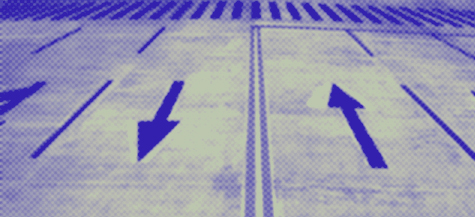 New Scientist reports that "lane markings on roads could one day be changed at the click of a mouse."
New Scientist reports that "lane markings on roads could one day be changed at the click of a mouse." If electronics firm Philips has its way, roadway markings will no longer use paint; instead, "ultrathin plastic strips would be attached to road surfaces." These would use "a hard-wearing version of the electronic ink used in emerging flexible displays for e-books" – transforming roads into a kind of literary hieroglyph, or infrastructural e-book.
Paving the way for Da Vinci Code 2: Road to Calvary, in which a strange message is found encoded in the pavement outside Mel Gibson's Malibu home...
More prosaically, this just means that "lane marking or speed limits [could] be changed at will." But whose will...? And does that mean that you could program the M25 to be like I-95 for a day, and vice versa? Exploring cultural exchange via roadway markings?
Of course, if these programmable markings do become an everyday reality, it will inevitably mean that every fifteen year-old on the planet will waste hours and hours trying to hack the local roadways, engineering gruesome pile-ups. J.G. Ballard will be arrested, remote control in hand, staring glassy-eyed through a window at the final crashes he has staged.
And, who knows, maybe somebody will figure out how to make these magic roadways show films. The face of Cary Grant, shining upward from a freeway in Montana.
Earth Surface Television™. Brought to you by BLDGBLOG.
No comments:
Post a Comment